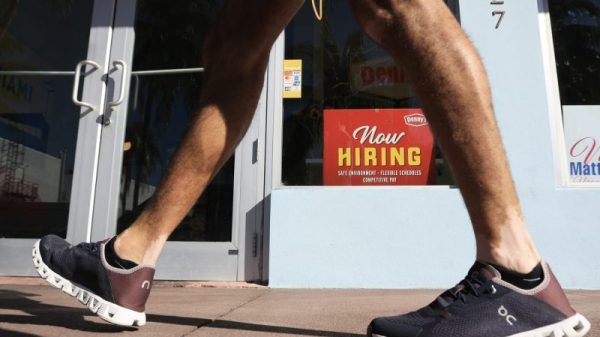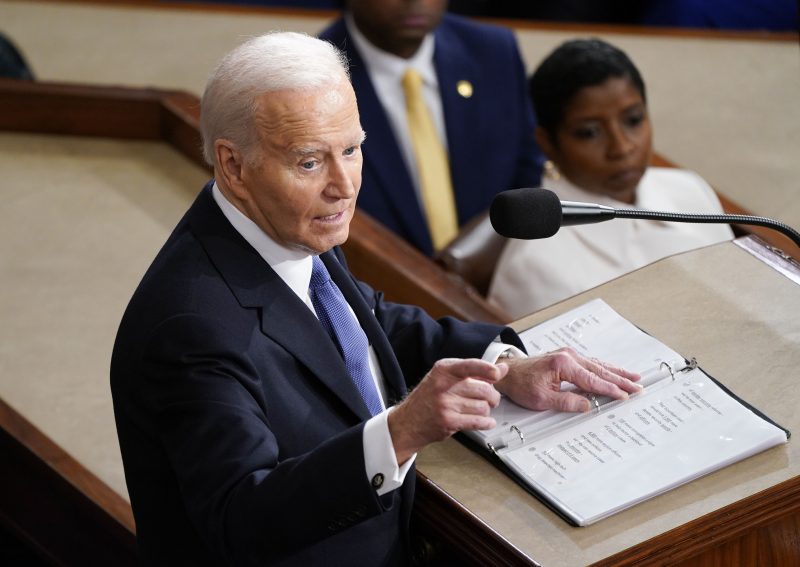A State of the Union address generally is a product of many hands and is carefully vetted. But State of the Union addresses are political speeches, an argument for the president’s policies, so context is sometimes missing. Here’s a roundup of a dozen claims in Tuesday night’s speech that caught our attention, listed in the order Biden made them.
As is our practice, we do not award Pinocchios in speech roundups.
“15 million new jobs in just three years — a record, a record!”
At the moment, Biden can claim a record for a presidential term, but he is comparing his jobs record for the first three years of his term to the full four-year terms of the previous presidents. That’s misleading. He has no idea what might happen in the last year of this term that could affect the final number.
Donald Trump found this out the hard way. In his 2020 State of the Union address, he bragged: “Incredibly, the average unemployment rate under my administration is lower than any administration in the history of our country.” But the coronavirus was already spreading across the globe, and within weeks the U.S. economy was shut down, throwing millions of people out of work. Trump’s record went from great to horrible.
That’s why it’s often misleading to measure job creation by presidential term — an artificial metric beloved by presidents and the public alike. Of course, the U.S. population was much smaller under other presidents with great jobs records, like Bill Clinton, Ronald Reagan and Franklin D. Roosevelt, so a raw-number record needs to be seen in that context.
Still, Biden’s job record in his first three years certainly tops Trump’s performance. In the first three years of his term, about 6.5 million jobs were created under Trump — less than half the number created under Biden in the same time period. The number of jobs is now 5.4 million higher than the peak under Trump on February 2020, before the pandemic struck the economy.
“800,000 new manufacturing jobs in America and counting.”
The number of manufacturing jobs has rebounded since the pandemic started, but growth in manufacturing jobs has essentially stalled since Biden last gave his State of the Union address. Only about 70,000 of the nearly 800,000 manufacturing jobs were created since Biden last addressed Congress 13 months ago, according to the Bureau of Labor Statistics.
The level reached in January, a tad under 13 million, is still below that of 2008, before the Great Recession. Left unsaid is that overall manufacturing jobs have declined by a third since a peak was reached in 1979, even as the number of available workers has climbed by nearly 60 percent.
“Inflation has dropped from 9% to 3% — the lowest in the world.”
This boast is no longer accurate. Biden presumably was comparing the United States to its peer countries, members of the Organization for Economic Co-operation and Development (OECD) and the Group of Seven. The U.S. inflation rate is much better than the OECD average of 5.7 percent. But other G-7 members such as Japan, Italy and Germany as of January had lower inflation rates. Italy’s inflation rate is below one percent, according to an OECD report this week.
“And now instead of importing foreign products and exporting American jobs, we’re exporting American products and creating American jobs — right here in America where they belong!”
Biden is being a bit slippery here because he’s only telling only part of the story. Exports are up, which means more U.S. products are being shipped overseas. But that does not necessarily mean jobs are no longer being shipped overseas. Imports are also up during his presidency, though they fell a bit last year.
According to the Census Bureau, exports in goods and services have climbed from $2.16 trillion in 2020 to $3.05 trillion in 2023.
But imports have also gone up, from $2.81 trillion in 2020 to $3.8 trillion last year. That total was down 3.7 percent from 2022, bringing the trade deficit down with it.
The trade figures obscure the fact that many manufacturers import goods that they use to manufacture products that are later shipped overseas. Some of those imports represent lost American jobs.
“Bring your prescription with you [overseas]. I promise you I’ll get it for you for 40%. The cost you’re paying now. Same company, same drug, same place, folks.”
This is basically correct, at least with similar countries (Biden referenced “Toronto, Berlin, Moscow”). A 2024 Rand study, using 2022 data, concluded that across all drugs, U.S. prices were 2.78 times higher than prices in 33 other countries that were also members of the OECD.
“Obamacare, known as the Affordable Care Act, is still a very big deal. Over one hundred million of you can no longer be denied health insurance because of preexisting conditions.”
This figure — over 100 million — is in dispute. Biden appears to be taking a high-end estimate from the Department of Health and Human Services that 50 to 129 million non-elderly Americans have some type of preexisting health condition. But before the ACA, state-run high-risk insurance pools did help some people with preexisting conditions.
Before the ACA was enacted, a 2010 investigation by the House Energy and Commerce Committee, based on documents from the four largest for-profit health insurers, found that companies denied coverage to one out of every seven applicants. So that would be 14 percent. So even if you took the entire U.S. population with health insurance — about 271 million people — that means 38 million would face a denial of coverage.
Meanwhile, a KFF study said that 27 percent of adult Americans younger than 65, about 54 million people, have “health conditions that would likely leave them uninsurable if they applied for individual market coverage under pre-ACA underwriting practices that existed in nearly all states.”
“I’ve already cut the federal deficit by over 1 trillion dollars.”
Biden misleadingly claims to have lowered the deficit by a huge amount even though his policies have added significantly to the national debt. How is this possible? Welcome to federal budget magic.
The Congressional Budget Office, the official scorekeeper, in February 2021 estimated the budget deficit would fall dramatically in fiscal years 2021, 2022 and 2023 because emergency pandemic spending would lapse.
But Biden enacted additional covid relief funds and other new policies, resulting in the more modest decline in the deficit — and thus a bigger increase in the national debt. For instance, the deficit was projected to be about $1 trillion in 2022, and it turned out to be about $1.4 trillion. The deficit continued to get worse in 2023, climbing from CBO’s original estimate of $963 billion to $1.68 trillion.
All told, Biden has increased the national debt nearly $1.6 trillion more than originally projected.
“The last administration enacted a $2 trillion tax cut that overwhelmingly benefits the top 1%, the very wealthy and the biggest corporation, and exploded the federal deficit. They added more to the national debt than any presidential term in American history. Check the numbers, folks.”
We did. Biden suggests Trump’s 2017 tax cut is responsible for most of the deficit during Trump’s presidency, but that’s wrong. The debt grew about $8 trillion during Donald Trump’s four years as president, or about 25 percent of the nation’s $31 trillion in debt. But a larger part of that was debt accumulated to help fund Medicare and Social Security as the baby boom generation began retiring — automatic spending over which Trump had no control.
Massive spending to stabilize the economy during the pandemic also added to the debt — but that was approved with vast bipartisan support. The tax cuts passed by Congress in 2017 helped add to the deficit — but not as much as various spending bills approved during his presidency.
“In 2020, 55 of the biggest companies in America made $40 billion and paid zero in federal income tax — zero.”
This is one of Biden’s favorite statistics and it pops up yet again in a State of the Union address. It’s not necessarily wrong, but there are some limitations.
The figure comes from a report issued in April 2021 by the left-leaning Institute on Taxation and Economic Policy. The group studied the corporate filings with the Securities and Exchange Commission of companies listed in the Fortune 500, zeroing in on companies that posted profits.
In 2020, ITEP found that 55 profitable companies indicated that they paid no federal income tax even though they collectively earned almost $40.5 billion in pretax income. ITEP previously had reported that 91 companies paid no federal income tax in 2018, so the situation has improved.
Company tax returns generally are not made public, so ITEP’s numbers are the product of its own research and analysis of public filings.
But it is an imperfect measure. A company’s annual 10-K filing in March generally will have only estimated numbers, as the actual tax return generally is not filed until later in the year. Total tax numbers may be determined from looking at cash flow statements, but there is no guarantee that the calculations reflect the actual tax liability.
Nevertheless, the notion that 10 to 20 percent of Fortune 500 companies do not pay federal income taxes is consistent with a 2020 report by the nonpartisan Joint Committee on Taxation. The JCT was able to examine the actual tax filings but could not reveal the names of the companies. It found that about 20 percent of the 50 corporations reported no tax liability on their tax returns. That mirrors ITEP’s examination of the Fortune 500.
“Thanks to the law I wrote and signed, big companies now have to pay a minimum of 15 percent.”
As part of the Inflation Reduction Act, Congress included a new 15 percent corporate minimum tax, beginning last year, on large corporations that for three years have an average financial statement income of over $1 billion. The Tax Foundation estimated that would raise $153 billion over 10 years — a relative pittance — and it could be less if companies figure out how to avoid it. The average effective tax rate under the corporate income tax would rise from 18.7 percent under current law to 19.3 percent.
“There are 1,000 billionaires in America. You know what the average federal tax rate for these billionaires is? … 8.2 percent! That’s far less than the vast majority of Americans pay. No billionaire should pay a lower tax rate than a teacher, a sanitation worker, or a nurse!”
This is another favorite line — the president has referenced this “fact” in more than 30 appearances over the past year — but Biden is comparing apples and oranges. We’ve given the president two Pinocchios for this claim.
The “lower tax rate” refers to a 2021 White House study concluding that the 400 wealthiest taxpayers paid an effective tax rate of 8 percent. But that estimate included unrealized gains in the income calculation. That’s not how the tax laws work. People are taxed on capital gains when they sell their stocks or other assets. So this is only a figure for a hypothetical tax system.
According to IRS data on the top 0.001% — 1,475 taxpayers with at least $77 million in adjusted gross income in 2020 — the average tax rate was 23.7 percent. The top 1 percent of taxpayers (income of at least $548,000) paid nearly 26 percent.
As for less-wealthy Americans, few, such as schoolteachers or firefighters, pay even the lowest rate of 10 percent because of deductions, exemptions and the like.
According to the Tax Policy Center, about 60 percent of all tax returns are filed by those with income under $50,000 — and about half of those pay no income tax at all; 22 percent paid an effective tax rate of less than 5 percent and another 22 percent paid less than 10 percent.
Among taxpayers with income between $50,000 and $100,000, about 60 percent paid an effective tax rate below 10 percent.
“Last year, the murder rate saw the sharpest decrease in history, and violent crime fell to one of the lowest levels in more than 50 years.”
This is correct. The official FBI numbers have not been released but preliminary data led analysts to predict the decline in murders in 2023 is expected to be the sharpest drop on record. Murders had spiked during the pandemic, as Biden noted, and he attributed the drop to investments in public safety made by his administration. But it’s too early to make a definite link.
(About our rating scale)
Send us facts to check by filling out this form
Sign up for The Fact Checker weekly newsletter
The Fact Checker is a verified signatory to the International Fact-Checking Network code of principles





























